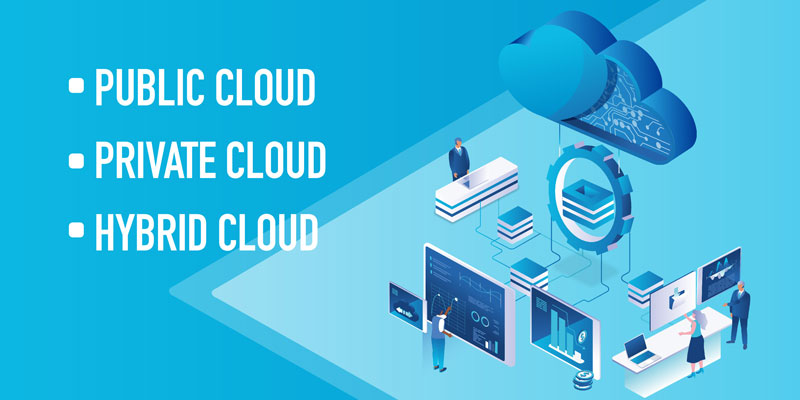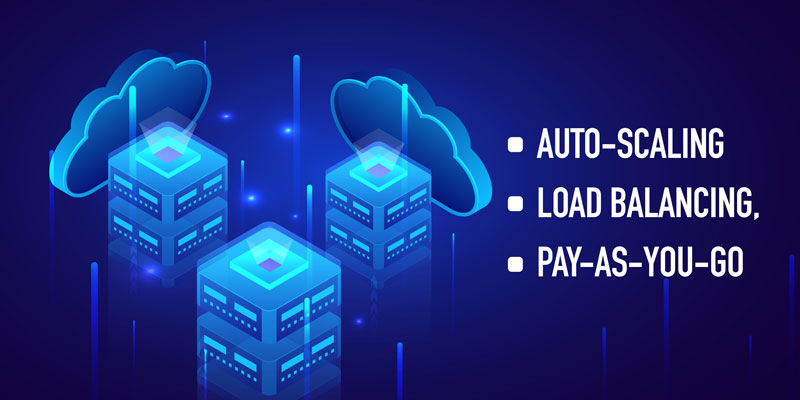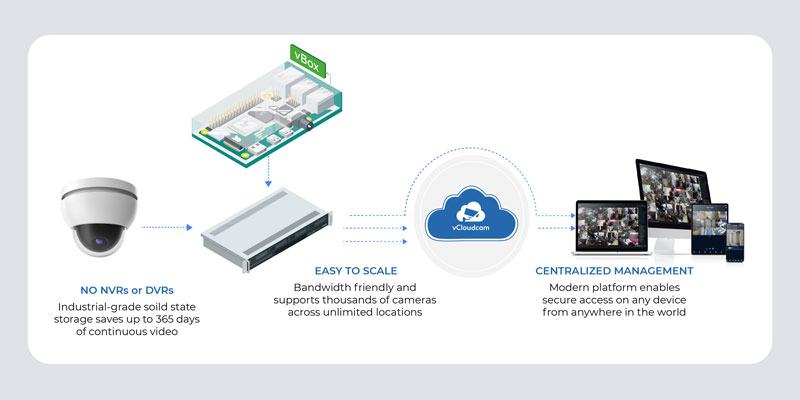VSaaS, which stands for "Video Surveillance as a Service," is a cloud-based solution for monitoring security cameras. The VSaaS service encompasses technologies and solutions that enable the storage, management, recording, and playback of camera images from the cloud platform. This eliminates the need to purchase specialized equipment and software for storing and managing camera image data. All that is required is the camera itself and an internet connection. The responsibility for these tasks lies with the VSaaS service provider.
Compared to traditional solutions based on Analog DVR or NVR connected to the internet for remote access or storage, the security camera monitoring system on the cloud - VSaaS - offers distinct advantages.
To make informed decisions about the technology that impacts your business, it is essential to understand the differences between VSaaS and traditional security camera solutions. This article aims to help you determine which system best suits the needs of your company or customers.
The formation of cloud computing and economies of scale
In Vietnam, approximately 5 out of 10 businesses are currently using cloud computing technology, which includes security camera monitoring. According to a report by RightScale, at least 88% of businesses utilize public cloud technology, while 63% make use of private cloud solutions. The majority of respondents in the survey indicated their use of cloud storage technology.

The Cloud model offers businesses significant economies of scale:
Reduced initial capital costs
One proven advantage of cost savings with Cloud technology is the reduction in initial capital costs, allowing companies to invest in other areas of business.
Make full use of your device's resources
Businesses benefit from shared server infrastructure by utilizing improved equipment and experiencing reduced costs for supporting workloads.
Reduced energy costs
Better hardware utilization means no idle server systems. When operating your own data center, it is rare to fully utilize all your servers. Inactive servers waste energy.
Reduced IT staffing costs
Costs associated with experienced IT staff, including salaries, often exceed the costs of hardware and software. IT personnel from cloud service providers typically maintain a shared infrastructure, allowing you to reduce your own IT costs or redirect staff to departments that provide greater business benefits.
Reliability and redundancy
To achieve a reliable system with high redundancy, additional equipment is required for protection against failures. Idle hardware is a costly factor that increases continuous system uptime.
Basic factors of the system
Cloud technology is still relatively new for security camera monitoring systems, leading to certain misconceptions.

The National Institute of Standards and Technology (NIST) under the U.S. Department of Commerce has developed a definition of cloud computing that clarifies several key points. NIST defines a cloud system with five "essential characteristics":
1. On-demand self-service
Users can automatically provision and configure the necessary functions without direct interaction with service provider staff.
2. Broad network access
On-demand capabilities are available over the network and accessed through standard mechanisms that support different platforms, such as mobile phones, tablets, laptops, workstations, etc.
3. Resource pooling
The computing resources of the service provider are pooled to serve multiple customers, with different physical and virtual resources allocated and reallocated according to customer demand. Examples of these resources include storage, processing, memory, and network bandwidth.
4. Fast scalability
Resources can be rapidly allocated and released to scale the system quickly based on demand.
5. Measured service
The cloud system automatically controls and optimizes resource usage through appropriate measuring tools based on the type of service.
Attributes and Models
To deliver the five essential characteristics of "true cloud," computing resources run on shared cloud infrastructure, which can be a public cloud or a private cloud. Let's see how this works for VSaaS compared to traditional DVR or NVR.
In a traditional system, the processing, recording, and management of video occur on the user's computer. The video may be available on the internet for viewing or storage.
With this Cloud solution, the processing and management of video are performed by the cloud. The system requires a Cloud transmission device to communicate with the camera system and the Cloud system. The Cloud transmission device helps centralize the connection of all cameras, encode and transmit data from the cameras to the Cloud, and most importantly, temporarily store camera data when there is no internet connection and upload it to the Cloud instantly when the connection is restored.
11 points of comparison: VSaaS and traditional cameras

The following feature comparisons will help you determine which system is best suited to your needs.
Efficiency and total cost of ownership
1. System installation
Deploying a traditional system is a lengthy and complex process. You need to install necessary software, configure routers, and set up storage servers. In contrast, VSaaS systems are deployed on-demand, with cameras automatically configured.
2. System support
Before the advent of cloud technology, most firmware updates and parameter settings were provided through manual support. With VSaaS, both hardware and software require significant cloud computing, and support is provided by the service provider (a third party).
3. Cost structure
Previously, the initial investment costs for hardware and software were high, while support costs were unpredictable, following the principle of "whoever does the work bears the cost."
The VSaaS model has an extremely low initial investment cost with the ability to estimate monthly operating costs. Customers only pay for the services they use. Service costs are based on the number of cameras connected, storage duration, and video quality.
4. Total cost of ownership
For DVR or NVR systems, the initial ownership costs stem from hardware, software, and installation expenses. These costs include service fees, network and system setup, backup, security system management, remote network access, IT staff time, idle equipment, data recovery, employee training, software updates, and various other expenses.
For VSaaS, the initial costs only include cameras and monthly storage fees. This helps reduce costs for infrastructure maintenance and accommodates the scaling of usage as the system expands or contracts (we will discuss this further).
Flexibility, scalability, and technology development
5. Flexibility in storage
Traditional systems store data locally and are limited by the capacity of the devices.
Cloud systems allow for flexible integration of local and cloud storage. You can access the same data regardless of where the camera images are viewed or stored. You can instantly increase the storage time of cameras without changing existing devices. As this system utilizes cloud infrastructure, it offers exceptional scalability and flexibility.
6. Adding and configuring cameras
Conventional systems support multiple types of analog and IP cameras. After completing the initial system deployment, users have to manually connect and configure new cameras.
VSaaS systems also support multiple analog and IP cameras. Once connected, the cameras are automatically configured.
7. Bandwidth management
Local video storage does not require internet channels. Cloud storage without internet access is insufficient. However, some cloud systems have enhanced bandwidth control.
At vCloudcam, you can impact internet access traffic by configuring cameras in your account. You can change video resolution, bit rate, and frame rate of the main stream. The bit rate reflects the level of stream compression and, therefore, determines the size of the compressed data stream.
8. Plan for the "Outdated" and APIs
Traditional systems become "outdated" more quickly, and firmware updates need to be manually downloaded, at best. APIs are closed, limiting functionality.
On the other hand, VSaaS providers deliver automatic updates over the internet. With ongoing support, the system continually evolves, gaining new features and capabilities. APIs for analysis, integration, and application are open and readily accessible to users.
Security, Remote Access, and Backup
9. Security
Users' desire for remote access to camera data leads to the fact that traditional DVR and NVR systems are typically connected to the internet by the integrator or system installer. This necessitates the installation and configuration of a firewall. Consequently, the end user must independently address various attack vectors, such as operating system vulnerabilities, open ports, and the camera's software.
Cloud-based video management systems, on the other hand, do not encounter these vulnerabilities.
9.1 Password
At first glance, camera passwords are considered a significant aspect of security. However, people continue to use simple passwords, which are highly convenient for hacking. Additionally, there is a sense of optimism towards passwords despite the news of 2.7 billion hacked accounts in 2019.
Most cameras available today come with a Graphical User Interface (GUI) that includes a pre-designed Login and Password section. Unfortunately, some installers fail to change the default password and keep the same one for all cameras.
Ideally, it is recommended to assign a unique, lengthy, and complex password to each camera. Implementing such a meticulous process takes time to set up, requires more intricate management, and becomes challenging to track. Consequently, many installers resort to using the same password for all cameras within the account.
For all cameras utilizing the vCloucam service, a reliable password is randomly generated during the camera connection process.
10. Remote access
In traditional systems, remote access to camera data is typically not initially integrated but added upon customer request. The quality of camera data access may be subpar, with intermittent streaming and low image quality. Additionally, the utilization of data encryption mechanisms at the source is rarely implemented.
The Cloud camera system was specifically designed to facilitate seamless remote access to camera data. This solution enables low-latency access to camera image data, supporting various browsers and mobile applications. Furthermore, certain systems, such as vCloudcam, encrypt the entire data stream captured by the camera and ensure encrypted data transmission to the Cloud.
11. Redundancy
Traditional systems exhibit varying levels of reliability, often leading to instability. Moreover, maintaining this level of reliability necessitates the constant involvement of internal IT staff. Duplicate servers are commonly left inactive, further contributing to the overall costs.
Cloud data centers, on the other hand, offer double and triple redundancy. The shared infrastructure ensures optimal server utilization and benefits from economies of scale. The advanced Cloud system also provides the capability of local video storage as a backup to prevent Internet connection issues.
Final thoughts
Following the established trend in other industries, security camera surveillance has undergone digital transformation with the adoption of Cloud infrastructure.
The growth of Video Surveillance as a Service (VSaaS) is driven by key factors such as the rapid deployment of new technologies, enhanced security, flexible storage options, and uninterrupted remote access.
From a financial perspective, VSaaS offers a lower cost of capital and reduced total cost of ownership, thanks to economies of scale. Additionally, the "Pay-as-you-go" model aligns better with the needs of end customers, integrators, and distributors, supporting service support, business growth, and continuous development.